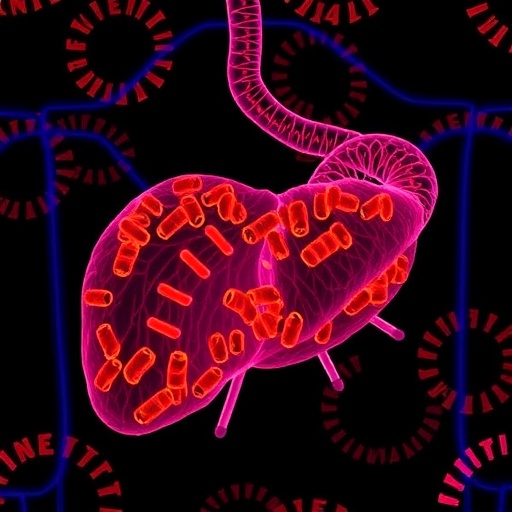In a groundbreaking new study published in Cell Death Discovery, researchers have uncovered critical insights into the molecular mechanisms driving hepatocellular carcinoma (HCC), the most common form of liver cancer globally. The team, led by Wang, Liu, and Lai, has identified the RNA-binding motif protein 17 (RBM17) as a central regulator in the progression of HCC, revealing its profound influence over lipid metabolism and the immune microenvironment within tumor tissue. This discovery opens promising vistas for targeted therapeutic strategies against one of the deadliest cancers.
Hepatocellular carcinoma remains a formidable clinical challenge, largely due to its complex pathogenesis and the limited effectiveness of existing therapies. The liver’s unique metabolic functions and immunological milieu contribute significantly to the complexity of HCC progression. By delving into the molecular underpinnings of this malignancy, Wang and colleagues aimed to elucidate how RBM17 orchestrates tumor growth and immune modulation, potentially unveiling new angles for intervention.
RBM17 is known to play multifaceted roles in RNA processing, including splicing and stability regulation. However, its involvement in cancer metabolism and immunity had remained elusive until now. Through a series of sophisticated molecular and cellular assays, the research team demonstrated how aberrant expression of RBM17 in hepatocellular carcinoma cells fuels oncogenic processes by reprogramming lipid metabolism pathways, enabling malignant cells to thrive under metabolic stress.
Metabolic reprogramming is a hallmark of cancer, with lipid metabolism increasingly recognized as a pivotal element for tumor development. Dysregulated lipid synthesis and degradation provide cancer cells with essential building blocks for membrane biogenesis and energy production. This study makes a compelling case that RBM17 amplifies these metabolic alterations, creating a feed-forward loop that sustains tumor survival and proliferation.
Beyond metabolism, the study highlights the critical influence of RBM17 on the tumor immune microenvironment (TIME). Tumors are not isolated entities; they interact dynamically with immune cells that can either suppress or promote cancer growth. Wang and colleagues uncovered that RBM17 modulates the infiltration and polarization of immune cell subsets, essentially sculpting an environment that favors immune evasion and tumor progression.
The researchers applied cutting-edge transcriptomic and proteomic analyses on patient-derived HCC samples and experimental models, pinpointing key downstream effectors regulated by RBM17. These downstream molecules govern lipid metabolic enzymes and immunomodulatory factors, which orchestrate the crosstalk between cancer cells and immune components. Decoding these molecular networks paves the way for precision medicine approaches targeting RBM17 and its effectors.
Significantly, the team demonstrated that silencing RBM17 expression in HCC cell lines resulted in impaired tumor growth, diminished lipid metabolic activity, and reinvigoration of anti-tumor immunity. These compelling functional validations underscore RBM17’s potential as a therapeutic target, particularly with strategies aimed at disrupting tumor metabolism and enhancing immune-mediated tumor clearance.
This discovery gains further importance in the context of current immunotherapies. While checkpoint inhibitors have transformed cancer treatment paradigms, their efficacy in HCC is inconsistent, partly due to an immunosuppressive microenvironment. Modulating RBM17 activity could potentially remodel this microenvironment to sensitize tumors to immune checkpoint blockade, offering a dual-pronged attack against cancer cells.
Moreover, the study also explored the regulatory mechanisms controlling RBM17 itself, revealing potential upstream signals and transcription factors that induce its overexpression in hepatocellular carcinoma. Understanding these regulatory axes not only enriches the biological narrative but also identifies additional nodes for therapeutic intervention.
The ramifications of this study transcend hepatocellular carcinoma, as RBM17 is expressed across various cancers. Its dual role in metabolic modulation and immune regulation suggests that RBM17 could be a universal target for multiple malignancies characterized by similar tumor microenvironment dynamics. Future investigations could explore its relevance in other tumor types, widening the impact of this foundational research.
Despite the promise, challenges remain in translating these findings into clinical applications. The development of small-molecule inhibitors or RNA-based therapeutics against RBM17 requires further optimization and rigorous safety evaluations. Furthermore, the complexity of lipid metabolism and immune interactions in vivo necessitates comprehensive preclinical studies to unravel potential off-target effects and resistance mechanisms.
Nevertheless, the insights gleaned by Wang et al. fuel optimism for the next generation of cancer therapies. By targeting fundamental tumor-supportive processes such as lipid metabolism and immune suppression, RBM17-focused interventions might overcome resistance to conventional treatments and deliver durable responses in HCC patients.
This research exemplifies the power of integrative molecular oncology, leveraging multi-omics data, sophisticated bioinformatics, and robust experimental validation. Such multidisciplinary approaches are indispensable in confronting the intricacies of cancer biology and propelling precision oncology toward clinical reality.
In summary, the identification of RBM17 as a master regulator that accelerates hepatocellular carcinoma progression through lipid metabolic reprogramming and immune microenvironment modulation marks a significant advance. This novel understanding invites the scientific and medical communities to develop innovative therapeutic strategies that could dramatically improve outcomes for patients suffering from liver cancer.
As the global burden of HCC continues to rise, insights from studies like this underscore the urgent need for translational research bridging molecular discoveries and patient care. RBM17 stands out as a beacon offering hope for better diagnostics, prognostics, and personalized treatment regimens in hepatocellular carcinoma.
Subject of Research: The role of RBM17 in hepatocellular carcinoma progression, focusing on its regulation of lipid metabolism and the immune microenvironment.
Article Title: RBM17 promotes hepatocellular carcinoma progression by regulating lipid metabolism and immune microenvironment: implications for therapeutic targeting.
Article References:
Wang, Z., Liu, J., Lai, Y. et al. RBM17 promotes hepatocellular carcinoma progression by regulating lipid metabolism and immune microenvironment: implications for therapeutic targeting. Cell Death Discov. 11, 338 (2025). https://doi.org/10.1038/s41420-025-02642-2
Image Credits: AI Generated




